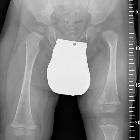Klassifikation proximaler Femurdefekt (PFFD)




Classification of proximal femoral deficiency (PFFD) can be complicated and numerous such classifications have been proposed. For a discussion of the condition refer to the article proximal focal femoral deficiency.
One of the simplest and most widely used is that proposed by Aitken which is based on the anatomic relationship between the acetabulum and the proximal end of the femur and designates four classes:
- class A
- this is the least severe type where the femoral head is present and attached to the shaft by the femoral neck.
- the femur is shortened (as in all types), and a coxa vara deformity is present
- a cartilaginous neck is not seen on early radiographs but later ossifies.
- occasionally, the cartilaginous connection between the neck and the shaft forms a subtrochanteric pseudarthrosis.
- class B
- in this type, the acetabulum is “adequate” or moderately dysplastic and contains the femoral head.
- at maturity, no osseous connection is seen between the femoral head and the shaft.
- the femoral segment is short and usually has a bulbous bony tuft.
- class C
- the acetabulum is severely dysplastic in this form.
- the femoral head is absent or is very small and not attached to the femoral shaft.
- the shortened femoral segment has a tapered proximal end.
- class D
- this is the most severe form, with the absence of the acetabulum and proximal femur.
- no proximal tuft is present.
Amstutz further subdivided Aitken’s classification into five types. He divided class A into types 1 and 2. Type 1 is reserved for the milder form with simple femoral shortening and coxa vara. In type 2, a subtrochanteric pseudarthrosis is present. The remaining types correspond to those of Aitken’s classification.
Several other classifications was proposed, but Aitken’s and Amstutz’s classifications
are the most widely used.
Since the management of type 1 varies from that of type 2, a distinction between them is necessary.
Siehe auch:

 Assoziationen und Differentialdiagnosen zu Klassifikation proximaler Femurdefekt (PFFD):
Assoziationen und Differentialdiagnosen zu Klassifikation proximaler Femurdefekt (PFFD):

